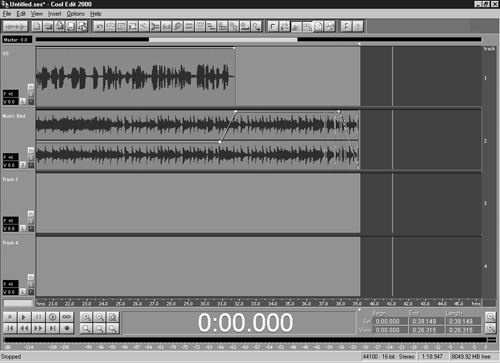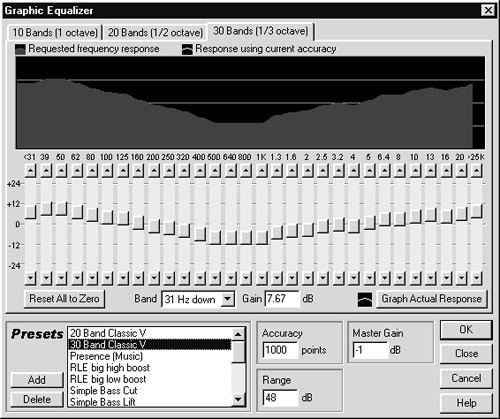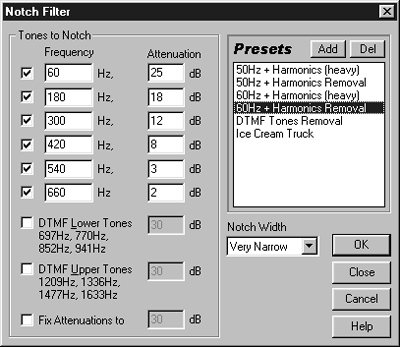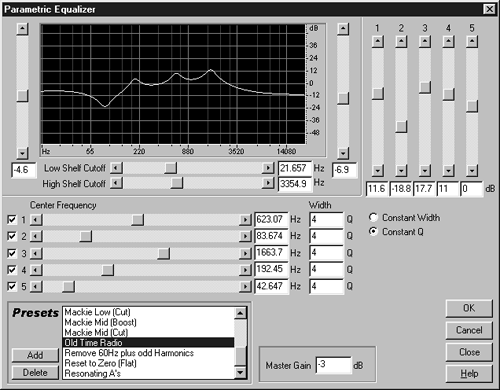EXPANDING COOL EDIT
As mentioned earlier, I installed the Studio Plug-In on my PC, which provides a new window and the ability to mix four channels of either mono or stereo files (see “The Multitrack View”). This also puts a new icon in the upper left corner of the Waveform View, and you can switch between the single Waveform View and the Multitrack View using that icon, or by touching the F12 key.
The Multitrack View doesn’t let you perform much of the surgical editing procedures that you can in the Waveform View. But from this view you can record more tracks, apply volume and panning envelopes, and slip bits of sound around, and it’s easy to switch between the two views. Yeah, it ain’t an Audicy, but you can do quite a bit of useful work in the Multitrack View.

For example, the Multitrack View provides “rubber-band” volume and panning envelopes. A typical use of these is in mixing a music bed with a voiceover (see “The Interview”). Here, the interview is on track one, and the stereo music bed is on track two. I’ve used Cool Edit 2000’s volume envelope to duck the music as the VO is playing, and to bring it back up after the VO finishes. And I still have two tracks left for adding sound effects.
While this is nothing special for big workstations, do remember that this power comes from a plug-in that costs less than fifty bucks, and turns a competent stereo editor into a multitrack workstation that can handle 90% of what we all do for a living. Pretty amazing stuff, if you ask me.
If you think you’re going to spring for Cool Edit 2000, do yourself a favor and spend the extra fifty for the Studio Plug-In. It’s less than the cost of a night out, and your payback will probably be greater depending on your situation...

MORE PLUGS, PLEASE
I also installed the Pro-EQ and Audio Cleanup Plug-Ins ($49 each). These plugs further expand Cool Edit 2000, and provide processing features that rival some high-end workstations.
The Pro-EQ Plug-In gives you access to a wide variety of very serious equalization processors. There’s a 10-, 20-, or 30-band graphic equalizer (see "The Graphic Equalizer"), a notch-filter for removing unwanted audio nasties (see “The Notch Filter”), and a five-band parametric equalizer (see “The Parametric EQ”).

Cool Edit 2000’s Audio Cleanup Plug-In is a real winner. Recently I had a project where I was given a ‘50s-vintage 2-track reel-to-reel of music from a deceased Cuban artist. After having the tape baked and putting it up on a rented 2-track recorder, I played it into the PC using Cool Edit 2000. The recording was excellent, but it had a lot of noise.

Using the Audio Cleanup Plug-In, I processed the recording. First, I used the Hiss Reduction feature to reduce tape noise (see The Hiss-Reduction Window). Then I used the Clip Restoration feature to smooth the parts that were recorded too hot.
The result was quite good, and was ready for mastering to CD. And I more than paid for the total cost of Cool Edit 2000 and its associated plug-ins on the job. What’s not to like?

GETTING HELP
You don’t get a printed manual with Cool Edit 2000, and Syntrillium does not offer telephone technical support. I gotta be honest — my first response to this information was “hmmm, that can’t be good.” But after a month with the software and its built-in help system, I think I can live with this.
Cool Edit 2000’s help system is comprehensive and clear. Touching F1 brings the online help to life, and you can search it by topic or keyword. Syntrillium Software also includes a multimedia tutorial that takes you through the features of Cool Edit 2000 step-by-step. Lastly, you can visit Syntrillium’s website at www.syntrillium.com where you’ll find their “Cool School” and more online help than I’ve ever seen on a website. They’ve built tutorials for nearly every operation in Cool Edit 2000, and there’s enough information there to get the rankest of amateurs up and running.
And for those who can’t find answers using these resources, Syntrillium offers support via email, and they promise an answer within two business days. I did not put this to the test, but I didn’t need to. My questions were all answered either in the help system or on the website. Like I said earlier, the basic program costs 69 bucks...
CLOSE IT OUT
Despite some early misgivings, I was surprised with what I was able to accomplish with Cool Edit 2000. It’s shareware, it’s cheap, but its performance is right up there with the high-priced spread. It didn’t crash on me once, and even when the power went south (thanks to electricity deregulation, don’t get me started please), Cool Edit 2000 picked up precisely where it left off when the lights were still on. No problemo.
Cool Edit 2000 isn’t perfect, but the latest version (1.1) does correct some deficiencies of the earlier versions. For example, you can now audition effects in real time, although you can’t apply them as you listen to them. But for what it sets out to do, Cool Edit 2000 is one of the more impressive audio editors available.
Let’s face it, we’d all like an Audicy or Pro Tools rig, but for most production tasks you need a VO track, a stereo music bed, and maybe a couple of tracks of sound effects. Cool Edit 2000 gives you all that, plus a rack of good-sounding effects and the ability to use Direct-X plugs. For far less than the cost of a print run of bumper stickers, your production department can have a full-blown digital audio workstation. Just go do it.
For more information in the US, contact Syntrillium Software Corporation, P.O. Box 62255, Phoenix, AZ 85082-2255. Phone: 480-941-4327, fax: 480-941-8170. For more information worldwide, go to www.syntrillium.com, or email
♦
